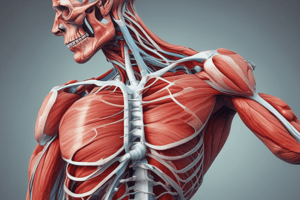Podcast
Questions and Answers
What is the primary function of skeletal muscles?
What is the primary function of skeletal muscles?
- Regulation of body temperature
- Facilitation of movement (correct)
- Storage of energy
- Production of hormones
What is the functional unit of skeletal muscle?
What is the functional unit of skeletal muscle?
- Sarcolemma
- Muscle fiber (correct)
- Myofibril
- Motor unit
What is the theory that explains muscle contraction?
What is the theory that explains muscle contraction?
- Motor unit recruitment
- Excitation-contraction coupling
- Sliding filament theory (correct)
- Neuromuscular transmission
What type of muscle fiber is responsible for high endurance and low force?
What type of muscle fiber is responsible for high endurance and low force?
What is the process by which a muscle action potential leads to muscle contraction?
What is the process by which a muscle action potential leads to muscle contraction?
What is the term for the accumulation of lactic acid and decreased ATP availability?
What is the term for the accumulation of lactic acid and decreased ATP availability?
What is the specialized region of the muscle fiber that receives neurotransmitters from the motor neuron?
What is the specialized region of the muscle fiber that receives neurotransmitters from the motor neuron?
What is the term for the process by which the motor neuron stimulates muscle contraction?
What is the term for the process by which the motor neuron stimulates muscle contraction?
Flashcards are hidden until you start studying
Study Notes
Skeletal Muscles Physiology
Functions
- Movement: contraction and relaxation of muscles to facilitate movement
- Support: maintenance of posture and stability
- Protection: protection of internal organs and bones
- Regulation: regulation of body temperature
Structure
- Muscle fiber: functional unit of skeletal muscle, composed of:
- Myofibrils: contain contractile proteins (actin and myosin)
- Sarcoplasm: cytoplasm of muscle fiber, contains mitochondria and myoglobin
- Sarcolemma: plasma membrane of muscle fiber
- Motor unit: group of muscle fibers innervated by a single motor neuron
Muscle Contraction
- Sliding filament theory: actin and myosin filaments slide past each other to produce contraction
- Excitation-contraction coupling: process by which a muscle action potential leads to muscle contraction
- Depolarization of sarcolemma
- Release of calcium ions from sarcoplasmic reticulum
- Binding of calcium to troponin and tropomyosin
- Sliding of actin and myosin filaments
Muscle Types
- Slow-twitch (Type I): high endurance, low force, aerobic respiration
- Fast-twitch (Type II): high force, low endurance, anaerobic respiration
- Intermediate (Type IIa): combination of type I and II characteristics
Neural Control
- Motor neurons: transmit signals from central nervous system to muscle fibers
- Motor end plate: specialized region of muscle fiber that receives neurotransmitters from motor neuron
- Neuromuscular transmission: process by which motor neuron stimulates muscle contraction
Muscle Fatigue
- Metabolic fatigue: accumulation of lactic acid and decreased ATP availability
- Neural fatigue: decreased neural transmission and muscle activation
Skeletal Muscles Physiology
Functions
- Facilitate movement through contraction and relaxation
- Maintain posture and stability through support
- Protect internal organs and bones
- Regulate body temperature
Structure
Muscle Fiber
- Composed of myofibrils, sarcoplasm, and sarcolemma
- Myofibrils contain contractile proteins (actin and myosin)
- Sarcoplasm contains mitochondria and myoglobin
- Sarcolemma is the plasma membrane of the muscle fiber
Motor Unit
- A group of muscle fibers innervated by a single motor neuron
Muscle Contraction
Sliding Filament Theory
- Actin and myosin filaments slide past each other to produce contraction
Excitation-Contraction Coupling
- Depolarization of sarcolemma leads to muscle contraction
- Release of calcium ions from sarcoplasmic reticulum
- Binding of calcium to troponin and tropomyosin
- Sliding of actin and myosin filaments
Muscle Types
Slow-Twitch (Type I)
- High endurance, low force, aerobic respiration
Fast-Twitch (Type II)
- High force, low endurance, anaerobic respiration
Intermediate (Type IIa)
- Combination of type I and II characteristics
Neural Control
Motor Neurons
- Transmit signals from the central nervous system to muscle fibers
Motor End Plate
- Specialized region of the muscle fiber that receives neurotransmitters from the motor neuron
Neuromuscular Transmission
- Process by which the motor neuron stimulates muscle contraction
Muscle Fatigue
Metabolic Fatigue
- Accumulation of lactic acid and decreased ATP availability
Neural Fatigue
- Decreased neural transmission and muscle activation
Studying That Suits You
Use AI to generate personalized quizzes and flashcards to suit your learning preferences.



